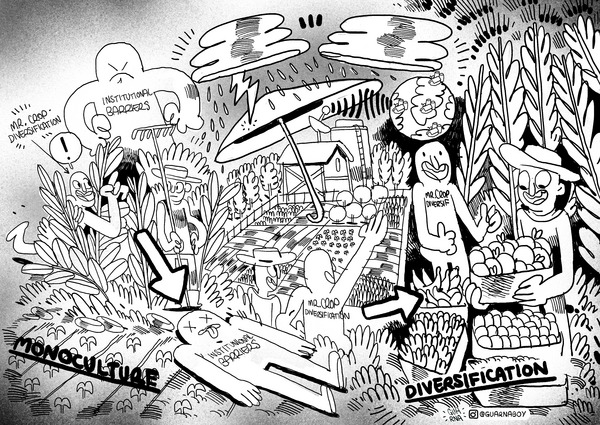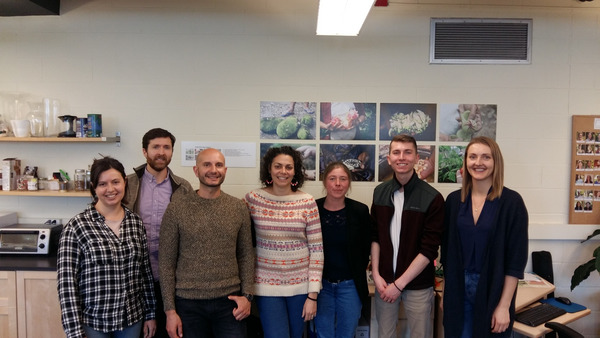The American Association for the Advancement of Science (AAAS) is the world’s largest general scientific society and the AAAS Annual meeting is one the world’s largest annual scientific gatherings, with more than 9,000 attendees from 50 countries this year. The European Commission (EC) sponsored the event and EU-funded projects, supported by the Research Executive Agency (REA), showcased their outcomes in five AAAS sessions. Addressing the conference theme “Envisioning Tomorrow’s Earth”, our session focused on how crop diversification and value chain reorganisation can help restore the global food supply in a sustainable manner.
Our session was organised around three talks:
- Based on Diverfarming field experiments, Raúl Zornoza, coordinator of Diverfarming (Polytechnic University of Cartagena, UPCT, Spain), discussed the benefits and drawbacks of crop diversification depending on diversification strategies and local contexts. He presented some of the negative impacts of current intensive monocultures on long-term sustainability owing to reduced biodiversity, high incidences of pests and disease, poor soil quality and fertility, soil and water pollution and overall simplification and low resilience. To address these problems, crop diversification has arisen as a suitable solution. Raúl Zornoza showed how rotations in arable crops, intercropping in horticulture and agroforestry strategies can increase soil organic matter, soil nutrients, biodiversity and crop yields. However, to observe the positive effects of rotations, they need to be long in duration and include legumes in the sequence. Intercropping vegetables is more effective when a legume is grown with a cash vegetable, when growing cycles are similar and when competition between species is reduced. For this, research is needed to assess the best combinations of species. Agroforestry systems including fruit trees or vineyards and fodder, vegetables or aromatics have proven efficient in increasing overall productivity and soil quality and fertility.
- Based on DiverIMPACTS case studies, Lise Paresys, the scientific officer of DiverIMPACTS (National Research Institute for Agriculture, Food and Environment, INRAE, France) emphasised the need to couple (i) innovations in activities across value chains; and (ii) technological innovations (e.g., technical knowledge on crop management, harvesting and processing equipment) with organisational innovations (e.g., different upstream and downstream organisational arrangements, cooperation between agri-food system actors) and institutional innovations (e.g., new policies and regulations) in order to unlock the potential of crop diversification and support sustainability transitions. She addressed strategies to support such developments in innovation niches and society. She shared the need to integrate multi-dimensional, multi-scale and multi-actor-oriented approaches in co-learning cycles to identify crop diversification options that fit local contexts and people, while meeting sustainability goals. In addition to designing tailored crop diversification options in innovation niches, she highlighted the need to expand the network of actors supporting crop diversification to create windows of opportunities for alternative pathways of development. She also emphasised the role of the CDC in addressing these issues.
- Our guest speaker, Meagan Schipanski (Colorado State University, CSU, Colorado), provided examples of the benefits of crop diversification for agroecosystem resilience, including benefits to multiple ecosystem functions and producer risk mitigation. She also shared common barriers to diversification identified through sociological interviews with dryland wheat producers, including the lack of markets for other crops. She highlighted whole food value chain approaches designed to evaluate and inform urban food policy initiatives to have positive outcomes for both rural and urban communities, including supporting crop diversification.
The three talks provided the ground for a lively discussion with the session attendees (Picture 1). During the session, Francesco Guarnaccia, an artist in the European ERCcOMICS project, made a live drawing of his interpretation of take-home messages (Picture 2).
DiverIMPACTS and Diverfarming also presented the Crop Diversification Cluster to the Diversified Agroecosystems Research cluster of the University of British Columbia (UBC-DARC, Vancouver, Canada) to initiate international networking (Picture 3). We presented each of our clusters and discussed potential linkages between the two clusters with a particular emphasis on multi-criteria assessments at the farm level. We also visited the UBC Farm, which acts as the Living Laboratory of several projects led by members of the UBC-DARC. Specifically, it was agreed that CDC partners can collaborate in the UBC LiteFarm management application to increase the dataset on sustainability indicators in Europe. In addition, CDC partners are invited to provide socioeconomic and biodiversity indicators about the implementation of crop diversification in Europe for the UBC SESYNC project on crop diversification. We agreed on an internal communication strategy between CDC and UBC-DARC to contact researchers to share and compare procedures, experiences, find researchers to participate in workshops and apply to future calls for research projects.
Further information
Links:
- aaas.org: 2020 AAAS Annual Meeting Archive
- ec.europa.eu: European funded research in AAAS 2020 – Tackling global challenges
- aaas.confex.com: Crop Diversification: Ensuring a Sustainable Global Food Supply
- zenodo.org: Benefits of Crop Diversification to Sustain Yields, Soil Quality and Biodiversity
- zenodo.org: Removing organisational and institutional barriers to crop diversification
- zenodo.org: Supply chain approaches to support crop diversification for mitigating risk and conserving resources
- ubcfarm.ubc.ca: Diversified Agroecosystems Research cluster
- ubcfarm.ubc.ca: Litefarm
- erccomics.com: About the project
- ubcfarm.ubc.ca: Can enhancing diversity help scale up agriculture's benefits to people and the environment?






 tap and then scroll down to the Add to Home Screen command.
tap and then scroll down to the Add to Home Screen command.